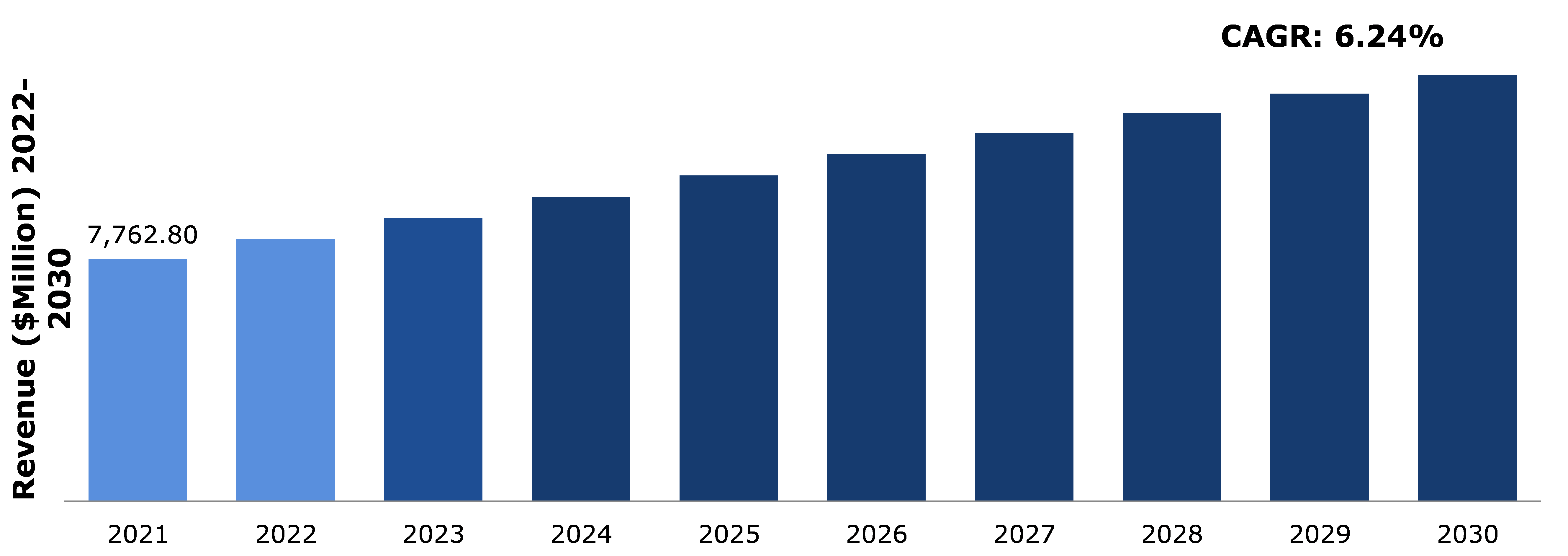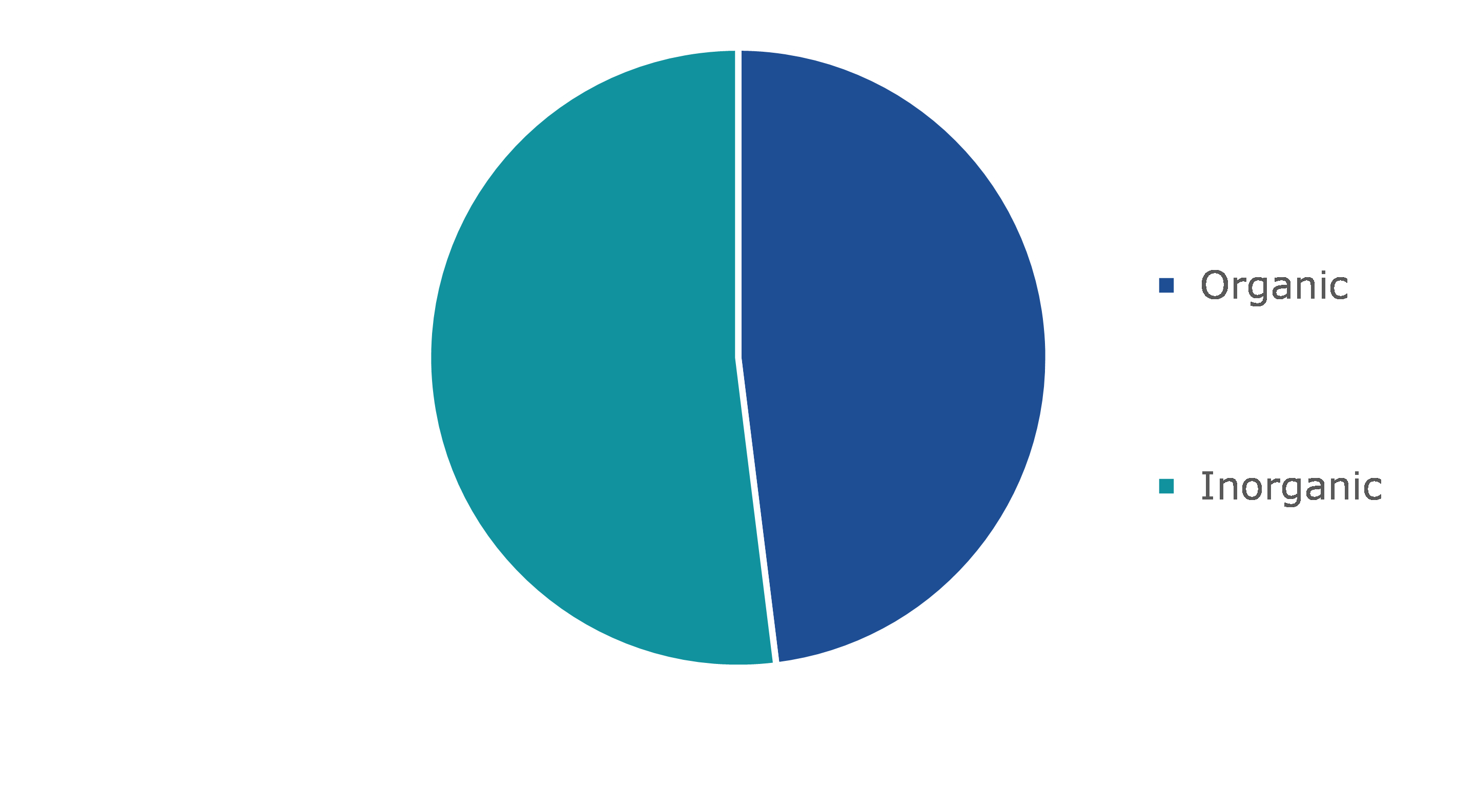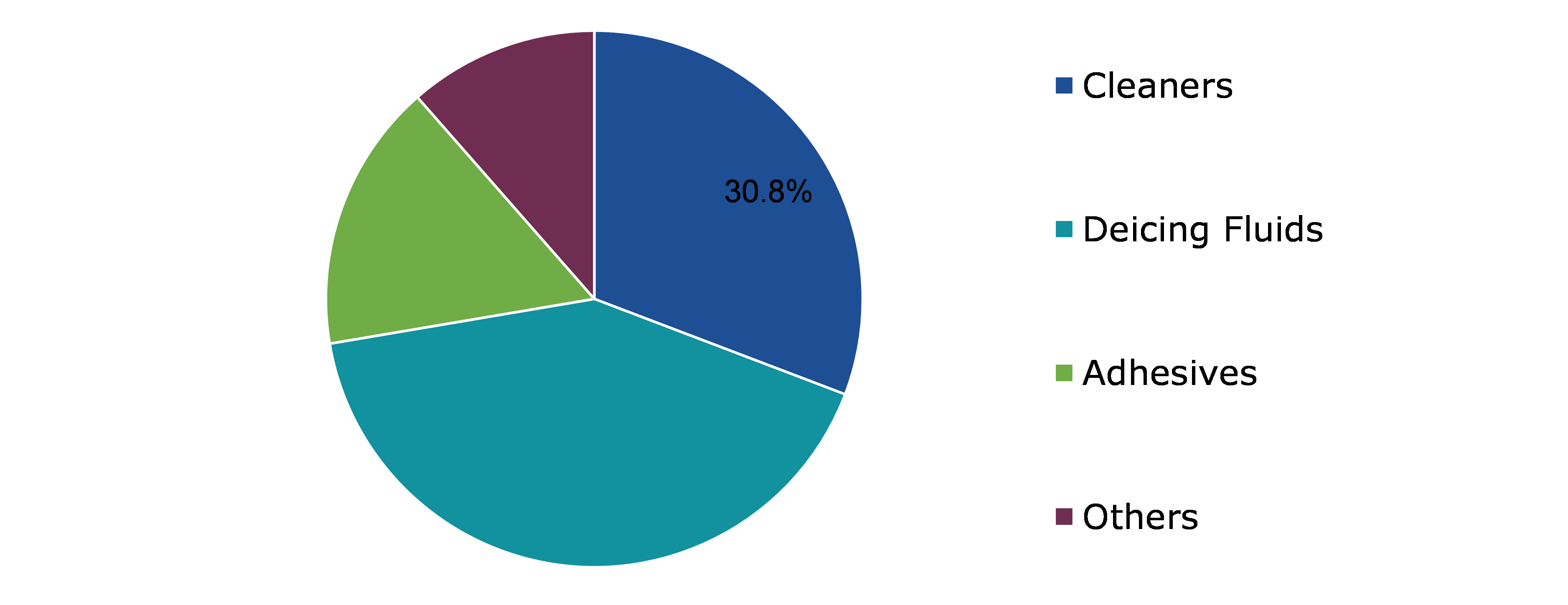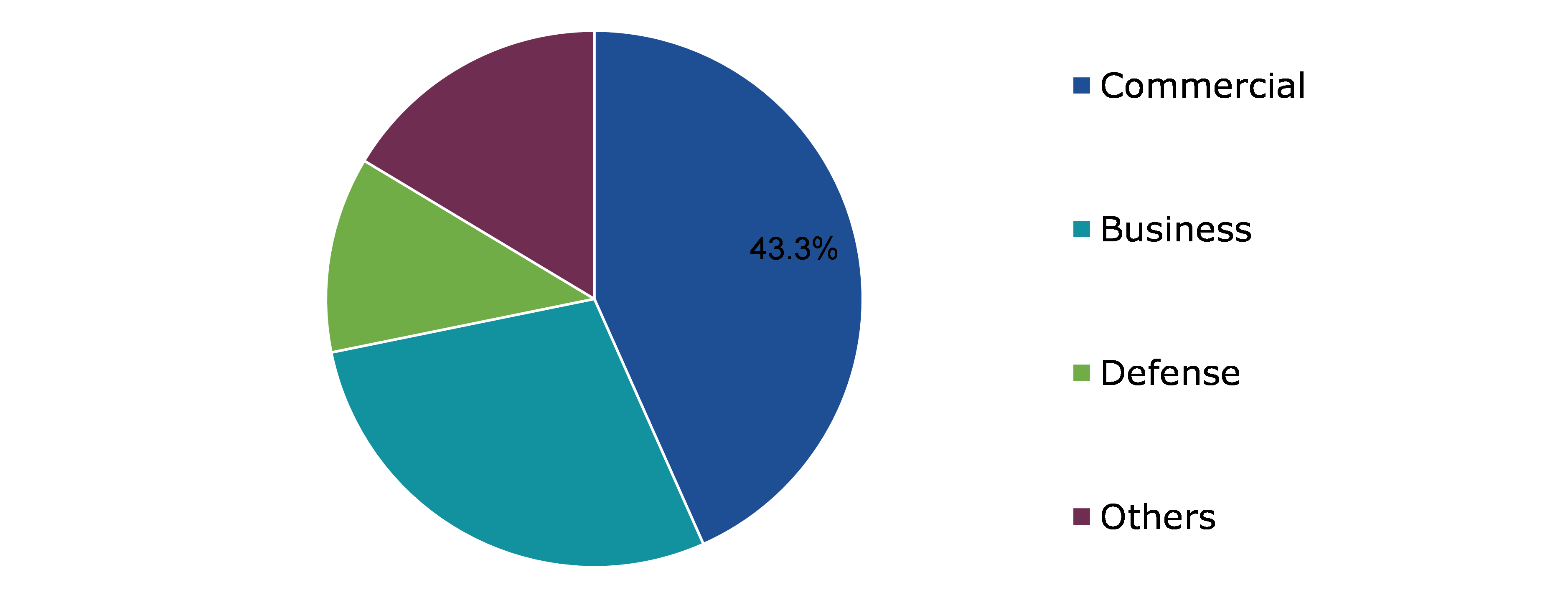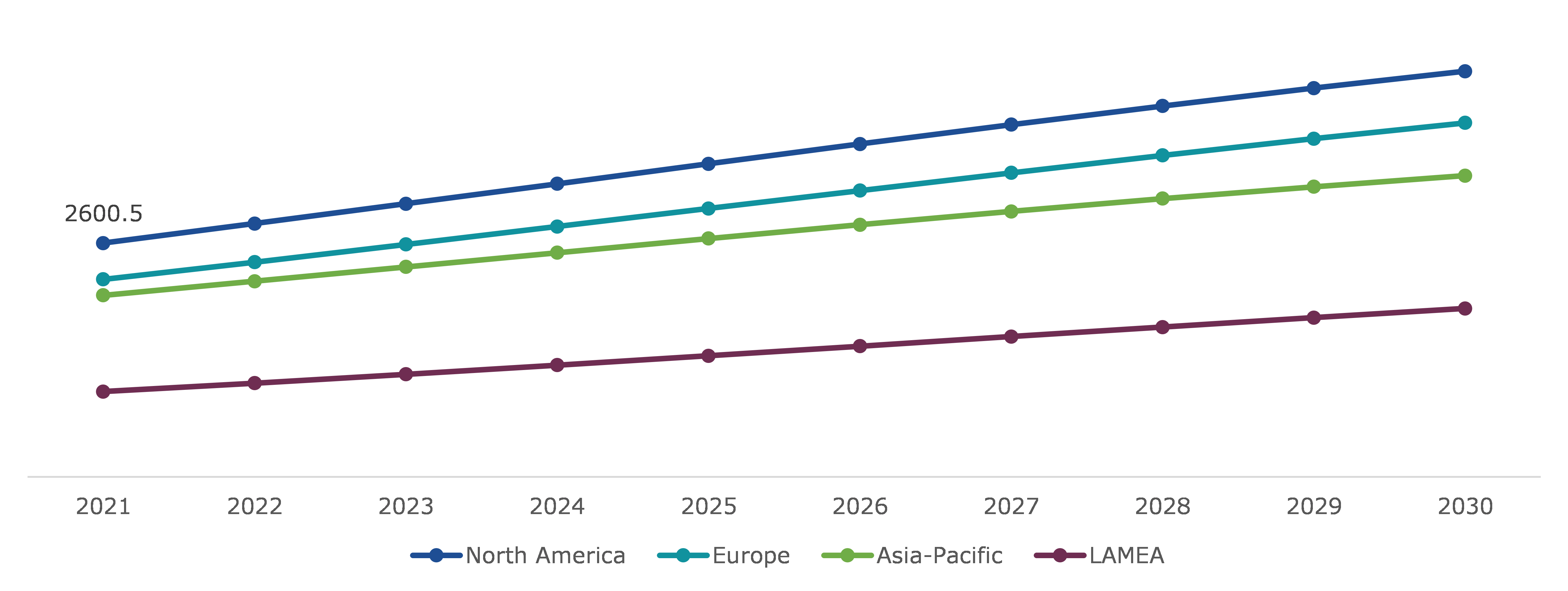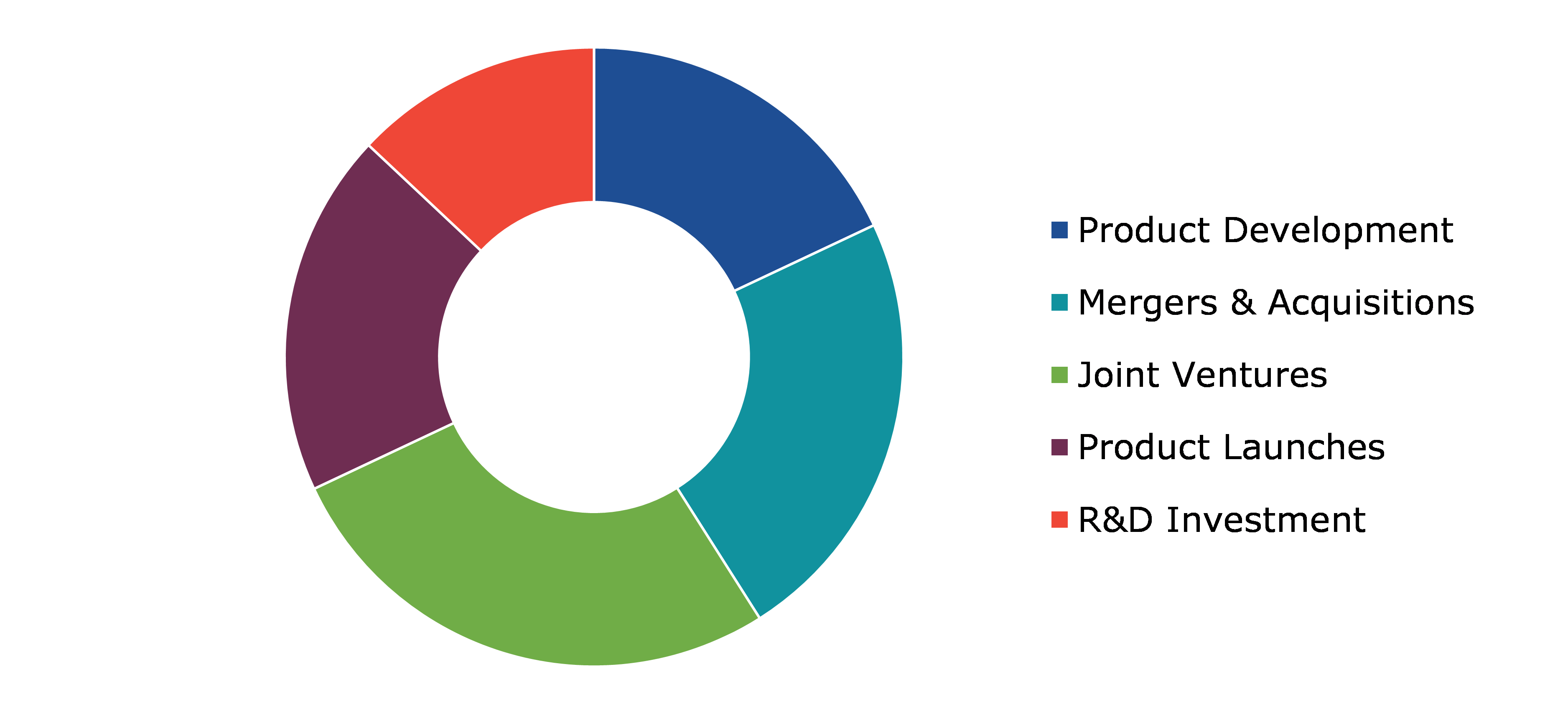Aerospace Maintenance Chemical Market Report
RA00027
Aerospace Maintenance Chemical Market by Nature (Organic and Inorganic), Product Type (Cleaners, Deicing Fluids, Adhesives, and Others), Type of Aircraft (Commercial, Business, Defense, and Others), and Regional Analysis (North America, Europe, Asia-Pacific, and LAMEA): Global Opportunity Analysis and Industry Forecast, 2021-2030
Global Aerospace Maintenance Chemical Market Analysis
The global aerospace maintenance chemical market is projected to garner $13,673.3 million by 2030, growing from $7,762.8 million in 2021, at a healthy CAGR of 6.24%.
Source: Research Dive Analysis
Market Synopsis
Aerospace maintenance chemical market revenue growth is expected to increase in the forecast time, owing to rising number of passengers flying across the world. Furthermore, strict regulations governing aircraft fleet safety and maintenance are driving revenue growth of the global aerospace maintenance chemical market. The aerospace maintenance chemicals are mostly used to clean the inside and outside of airplanes.
However, obstacles such as rising maintenance costs, scarcity of skilled labor, and schedule restrictions may limit the aircraft maintenance market revenue growth in the coming years. Furthermore, the aerospace maintenance chemical market expansion is hampered due to tight compliance of various aviation regulations.
According to the regional outlook, the North America aerospace maintenance chemical market is expected to create massive growth opportunities for market investors during the review period, owing to encouraged global aerospace maintenance chemicals providers in the region.
Aerospace Maintenance Chemical Overview
Aircraft maintenance is the overhaul, repair, and inspection of an aircraft and its components. Moreover, chemicals which are used to maintain corrosion free environment and cleanliness for internal and external parts of the aircrafts are known as aerospace maintenance chemicals. These chemicals mainly include paint removers, specialty solvents, brighteners, and others. Furthermore, these chemicals are utilized in leather cleaning, brake cleaning, paint removal, and other applications. Increase in transport of airline along with rise in air travelers and decreasing air fares is expected to drive the aerospace maintenance chemical market growth.
COVID-19 Impact on Aerospace Maintenance Chemical Market
Impact of COVID-19 on the aeroplane maintenance chemical market has been negative. Lockdowns enacted around the world had a significant impact on the aviation industry. The COVID-19 pandemic interrupted air travel and resulted in significant financial losses for several small or newly established carriers. As a result, various airlines were forced to cease operations. Additionally, the aviation industry was completely shut down during the epidemic, resulting in a significant fall in demand for chemicals for aircraft cleaning and maintenance. This hampered the expansion of the aircraft maintenance chemicals sector by causing a considerable drop in chemical sales. Many businesses were severely impacted by the COVID-19 pandemic, but the aviation industry has been particularly hard hit. All these factors are anticipated to hamper revenue growth of aerospace maintenance chemical market during the projected time.
Rapidly Increasing Number of Passengers Travelling by Plane is Anticipated to Drive Market Growth
The aerospace maintenance chemical market is being driven by rising air passenger traffic and flight frequency around the globe, leading to an increase in people's inclination for luxury, clean, and safe air travel. Need for new aeroplanes has increased significantly as the number of passengers has increased. The rising stringency of safety and environmental requirements by government agencies such as the U.S. Federal Aviation Administration and the European Authority in Aviation Safety is driving revenue growth of the aerospace maintenance chemical market. Due to increasing complexity of airframes, systems, and engines, there is a greater demand for aircraft maintenance, repair, and overhaul (MRO), which includes routine inspection, engine maintenance, and composite repair, which is driving demand for aerospace maintenance chemicals across the globe. Increased air traffic, combined with an increase in number of trips performed every day, is also driving revenue growth of the market.
To know more about global aerospace maintenance chemical market trends, get in touch with our analysts here.
High Cost of Chemical for Aircraft Maintenance to Restrain the Market Growth
Due to shorter shelf life of chemicals and requirement for sufficient storage facilities with appropriate temperature & humidity, cost of chemical inventory is increasing. Hazardous nature of several chemicals is producing health difficulties for plane mechanics, placing pressure on industry participants to develop new products with fewer harmful components. Furthermore, government regulations such as the Registration, Evaluation, Authorization, and Restriction of Chemicals (REACH) law require industry participants to discover alternate cleaners and solutions. All such factors are predicted to restrict the market revenue growth in the forecast period.
Growing Preference for Flight Travel Among People is Expected to Create Opportunities for Aerospace Maintenance Chemical Market
Throughout the forecast period, rising demand for comfortable and easy travel is projected to fuel revenue growth of the aerospace maintenance chemical market. As demand for environment friendly chemicals increases, the global aeroplane maintenance chemical market is expected to grow significantly in the next years. Aircraft emissions of toxic and destructive chemicals have a huge environmental impact. As a result, manufacturers are focusing their efforts on developing ‘environmentally friendly aviation chemicals’, which are expected to offer a multitude of opportunities to market participants over the forecast period.
To know more about global aerospace maintenance chemical market opportunities, get in touch with our analysts here.
Global Aerospace Maintenance Chemical Market, by Nature
Based on nature, the market has been divided into organic and inorganic. The inorganic sub-segment is expected to be the most dominating and the fastest growing during the forecast period.
Global Aerospace Maintenance Chemical Market Share, by Nature, 2021
Source: Research Dive Analysis
The inorganic sub-segment has been boosted due to rising demand for air travel in economies such as China and India as a result of rising people’s per capita income due to economic development. As inorganic compounds have a longer shelf life and are inexpensive, they are frequently employed to maintain aircraft quality. Inorganic chemicals may also be manufactured and stored in huge quantities, aiding expansion of the aerospace maintenance chemicals sector.
Global Aerospace Maintenance Chemical Market, by Product Type
Based on product type, the market has been sub-segmented into cleaners, deicing fluids, adhesives, and others. Among the mentioned sub-segments, the deicing fluids sub-segment is estimated to show a dominant share, whereas the others sub-segment is projected to garner the fastest growth.
Global Aerospace Maintenance Chemical Market Share, by Product Type, 2021
Source: Research Dive Analysis
The deicing fluids sub-segment is anticipated to have a considerable growth in the forecast time. The deicing fluid is an essential chemical required for proper maintenance of the aircraft. Deicing fluid is a mixture of propylene glycol, which is sprayed on aircraft surface to melt or remove ice and snow deposited on the flight surface while flying. Demand for deicing fluids is expected to increase further as it is mandatory for aircrafts to spray deicing fluids on the flight before take-off and after landing, to avoid deposit of any ice particles on plane surface. These factors are predicted to have a positive impact on the aerospace maintenance chemical market revenue growth.
Global Aerospace Maintenance Chemical Market, by Type of Aircraft
Based on type of aircraft, the market has been sub-segmented into commercial, business, defense, and others. Among the mentioned sub-segments, the commercial sub-segment is estimated to show a dominant share and garner the fastest growth.
Global Aerospace Maintenance Chemical Market Share, by Type of Aircraft, 2021
Source: Research Dive Analysis
The commercial sub-segment is anticipated to have considerable market share in 2030. Rapidly increasing number of passengers travelling by plane is anticipated to generate huge opportunities for major players operating in the aerospace maintenance chemical market in the forecast period. As per capita income of people has increased, their flight fare affordability has also increased. Thus, to save their time and have a luxurious flight, people have now opted to travel by plane which has increased demand for new aircrafts. This factor has risen demand for chemicals for proper maintenance of the aircraft and has contributed positively to the aerospace maintenance chemical market growth.
Global Aerospace Maintenance Chemical Market, Regional Insights:
The aerospace maintenance chemical market was inspected across North America, Europe, Asia-Pacific, and LAMEA.
Global Aerospace Maintenance Chemical Market Size & Forecast, by Region, 2021-2030 (USD Million)
Source: Research Dive Analysis
The Market for Aerospace Maintenance Chemical in North America to Hold the Maximum Revenue
The North America aerospace maintenance chemical market growth is majorly due to the increasing business and commercial aviation industry in the region, which has the biggest demand for aerospace and defense aircrafts in the globe. Furthermore, faster incorporation of technologies and significant investment in R&D activities in the aviation sector are expected to fuel aerospace maintenance chemicals industry growth in future. Several prominent industry players, including 3M Company and Eastman Chemical Company have started focusing their efforts on providing advanced aircraft maintenances chemicals in bulk, which is further projected to contribute to the market revenue growth. Furthermore, North America has seen a growth in aircraft deliveries in both commercial and defense uses in recent years, which is expected to fuel the aerospace maintenance chemical market in the region.
Competitive Scenario in the Global Aerospace Maintenance Chemical Market
Product launches and mergers & acquisitions are common strategies followed by major market players.
Source: Research Dive Analysis
The companies involved in the global aerospace maintenance chemical market are Exxon Mobil Corporation, Henkel AG & Co. KGaA, Arrow Solutions, Eastman Chemical Company, Florida Chemical, Dow, Nuvite Chemical Compounds, Aircraft Spruce, Nexeo Solutions, and High Performance Composites & Coatings Pvt Ltd.
| Aspect | Particulars |
| Historical Market Estimations | 2020-2021 |
| Base Year for Market Estimation | 2021 |
| Forecast Timeline for Market Projection | 2021-2030 |
| Geographical Scope | North America, Europe, Asia-Pacific, LAMEA |
| Segmentation by Nature |
|
| Segmentation by Product Type |
|
| Segmentation By Type of Aircraft |
|
| Key Companies Profiled |
|
Q1. What is the size of the global aerospace maintenance chemical market?
A. The global aerospace maintenance chemical market is projected to garner $13,673.3 million by 2030, growing from $7,762.8 million in 2021, at a healthy CAGR of 6.24%.
Q2. Which are the major companies in the aerospace maintenance chemical market?
A. Henkel AG & Co. KGaA is one of the key players in the global aerospace maintenance chemical market.
Q3. Which region, among others, possesses greater investment opportunities in the near future?
A. The Asia-Pacific region possesses great investment opportunities for investors to witness the most promising growth in the future.
Q4. What will be the growth rate of the Asia-Pacific aerospace maintenance chemical market?
A. Asia-Pacific aerospace maintenance chemical market is anticipated to grow at 5.54% CAGR during the forecast period.
Q5. What are the strategies opted by the leading players in this market?
A. New product development and strategic partnerships are the key strategies opted by the operating companies in this market.
Q6. Which sub-segment is expected to drive growth of the aerospace maintenance chemical market in next 5 years?
A. Commercial aircraft sub-segment is expected to drive growth of the aerospace maintenance chemical market in next 5 years.
1.Research Methodology
1.1.Desk Research
1.2.Real time insights and validation
1.3.Forecast model
1.4.Assumptions and forecast parameters
1.5.Market size estimation
1.5.1.Top-down approach
1.5.2.Bottom-up approach
2.Report Scope
2.1.Market definition
2.2.Key objectives of the study
2.3.Report overview
2.4.Market segmentation
2.5.Overview of the impact of COVID-19 on Global aerospace maintenance chemical market
3.Executive Summary
4.Market Overview
4.1.Introduction
4.2.Growth impact forces
4.2.1.Drivers
4.2.2.Restraints
4.2.3.Opportunities
4.3.Market value chain analysis
4.3.1.List of raw material suppliers
4.3.2.List of manufacturers
4.3.3.List of distributors
4.4.Innovation & sustainability matrices
4.4.1.Product type matrix
4.4.2.Regulatory matrix
4.5.Porter’s five forces analysis
4.5.1.Bargaining power of suppliers
4.5.2.Bargaining power of consumers
4.5.3.Threat of substitutes
4.5.4.Threat of new entrants
4.5.5.Competitive rivalry intensity
4.6.PESTLE analysis
4.6.1.Political
4.6.2.Economical
4.6.3.Social
4.6.4.Technological
4.6.5.Environmental
4.7.Impact of COVID-19 on aerospace maintenance chemical market
4.7.1.Pre-covid market scenario
4.7.2.Post-covid market scenario
5.Aerospace Maintenance Chemical Market Analysis, by Nature
5.1.Organic
5.1.1.Market size and forecast, by region, 2021-2030
5.1.2.Comparative market share analysis, 2021 & 2030
5.2.Inorganic
5.2.1.Market size and forecast, by region, 2021-2030
5.2.2.Comparative market share analysis, 2021 & 2030
5.3.Research Dive Exclusive Insights
5.3.1.Market attractiveness
5.3.2.Competition heatmap
6.Aerospace Maintenance Chemical Market, by Product Type
6.1.Cleaners
6.1.1.Market size and forecast, by region, 2021-2030
6.1.2.Comparative market share analysis, 2021 & 2030
6.2.Deicing Fluids
6.2.1.Market size and forecast, by region, 2021-2030
6.2.2.Comparative market share analysis, 2021 & 2030
6.3.Adhesives
6.3.1.Market size and forecast, by region, 2021-2030
6.3.2.Comparative market share analysis, 2021 & 2030
6.4.Others
6.4.1.Market size and forecast, by region, 2021-2030
6.4.2.Comparative market share analysis, 2021 & 2030
6.5.Research Dive Exclusive Insights
6.5.1.Market attractiveness
6.5.2.Competition heatmap
7.Aerospace Maintenance Chemical Market, by Type of Aircraft
7.1.Commercial
7.1.1.Market size and forecast, by region, 2021-2030
7.1.2.Comparative market share analysis, 2021 & 2030
7.2.Business
7.2.1.Market size and forecast, by region, 2021-2030
7.2.2.Comparative market share analysis, 2021 & 2030
7.3.Defense
7.3.1.Market size and forecast, by region, 2021-2030
7.3.2.Comparative market share analysis, 2021 & 2030
7.4.Others
7.4.1.Market size and forecast, by region, 2021-2030
7.4.2.Comparative market share analysis, 2021 & 2030
7.5.Research Dive Exclusive Insights
7.5.1.Market attractiveness
7.5.2.Competition heatmap
8.Aerospace Maintenance Chemical Market, by Region
8.1.North America
8.1.1.U.S.
8.1.1.1.Market size analysis, by nature
8.1.1.2.Market size analysis, by product type
8.1.1.3.Market size analysis, by type of aircraft
8.1.2.Canada
8.1.2.1.Market size analysis, by nature
8.1.2.2.Market size analysis, by product type
8.1.2.3.Market size analysis, by type of aircraft
8.1.3.Mexico
8.1.3.1.Market size analysis, by nature
8.1.3.2.Market size analysis, by product type
8.1.3.3.Market size analysis, by type of aircraft
8.1.4.Research Dive Exclusive Insights
8.1.4.1.Market attractiveness
8.1.4.2.Competition heatmap
8.2.Europe
8.2.1.Germany
8.2.1.1.Market size analysis, by nature
8.2.1.2.Market size analysis, by product type
8.2.1.3.Market size analysis, by type of aircraft
8.2.2.U.K.
8.2.2.1.Market size analysis, by nature
8.2.2.2.Market size analysis, by product type
8.2.2.3.Market size analysis, by type of aircraft
8.2.3.France
8.2.3.1.Market size analysis, by nature
8.2.3.2.Market size analysis, by product type
8.2.3.3.Market size analysis, by type of aircraft
8.2.4.Spain
8.2.4.1.Market size analysis, by nature
8.2.4.2.Market size analysis, by product type
8.2.4.3.Market size analysis, by type of aircraft
8.2.5.Italy
8.2.5.1.Market size analysis, by nature
8.2.5.2.Market size analysis, by product type
8.2.5.3.Market size analysis, by type of aircraft
8.2.6.Rest of Europe
8.2.6.1.Market size analysis, by nature
8.2.6.2.Market size analysis, by product type
8.2.6.3.Market size analysis, by type of aircraft
8.2.7.Research Dive Exclusive Insights
8.2.7.1.Market attractiveness
8.2.7.2.Competition heatmap
8.3.Asia-Pacific
8.3.1.China
8.3.1.1.Market size analysis, by nature
8.3.1.2.Market size analysis, by product type
8.3.1.3.Market size analysis, by type of aircraft
8.3.2.Japan
8.3.2.1.Market size analysis, by nature
8.3.2.2.Market size analysis, by product type
8.3.2.3.Market size analysis, by type of aircraft
8.3.3.India
8.3.3.1.Market size analysis, by nature
8.3.3.2.Market size analysis, by product type
8.3.3.3.Market size analysis, by type of aircraft
8.3.4.Australia
8.3.4.1.Market size analysis, by nature
8.3.4.2.Market size analysis, by product type
8.3.4.3.Market size analysis, by type of aircraft
8.3.5.South Korea
8.3.5.1.Market size analysis, by nature
8.3.5.2.Market size analysis, by product type
8.3.5.3.Market size analysis, by type of aircraft
8.3.6.Rest of Asia-Pacific
8.3.6.1.Market size analysis, by nature
8.3.6.2.Market size analysis, by product type
8.3.6.3.Market size analysis, by type of aircraft
8.3.7.Research Dive Exclusive Insights
8.3.7.1.Market attractiveness
8.3.7.2.Competition heatmap
8.4.LAMEA
8.4.1.Brazil
8.4.1.1.Market size analysis, by nature
8.4.1.2.Market size analysis, by product type
8.4.1.3.Market size analysis, by type of aircraft
8.4.2.Saudi Arabia
8.4.2.1.Market size analysis, by nature
8.4.2.2.Market size analysis, by product type
8.4.2.3.Market size analysis, by type of aircraft
8.4.3.UAE
8.4.3.1.Market size analysis, by nature
8.4.3.2.Market size analysis, by product type
8.4.3.3.Market size analysis, by type of aircraft
8.4.4.South Africa
8.4.4.1.Market size analysis, by nature
8.4.4.2.Market size analysis, by product type
8.4.4.3.Market size analysis, by type of aircraft
8.4.5.Rest of LAMEA
8.4.5.1.Market size analysis, by nature
8.4.5.2.Market size analysis, by product type
8.4.5.3.Market size analysis, by type of aircraft
8.4.6.Research Dive Exclusive Insights
8.4.6.1.Market attractiveness
8.4.6.2.Competition heatmap
9.Competitive Landscape
9.1.Top winning strategies, 2021
9.1.1.By strategy
9.1.2.By year
9.2.Strategic overview
9.3.Market share analysis, 2021
10.Company Profiles
10.1.Exxon Mobil Corporation
10.1.1.Overview
10.1.2.Business segments
10.1.3.Product portfolio
10.1.4.Financial performance
10.1.5.Recent developments
10.1.6.SWOT analysis
10.2.Henkel AG & Co. KGaA
10.2.1.Overview
10.2.2.Business segments
10.2.3.Product portfolio
10.2.4.Financial performance
10.2.5.Recent developments
10.2.6.SWOT analysis
10.3.Nexeo Solutions
10.3.1.Overview
10.3.2.Business segments
10.3.3.Product portfolio
10.3.4.Financial performance
10.3.5.Recent developments
10.3.6.SWOT analysis
10.4.Arrow Solutions
10.4.1.Overview
10.4.2.Business segments
10.4.3.Product portfolio
10.4.4.Financial performance
10.4.5.Recent developments
10.4.6.SWOT analysis
10.5.Eastman Chemical Company
10.5.1.Overview
10.5.2.Business segments
10.5.3.Product portfolio
10.5.4.Financial performance
10.5.5.Recent developments
10.5.6.SWOT analysis
10.6.Florida Chemical
10.6.1.Overview
10.6.2.Business segments
10.6.3.Product portfolio
10.6.4.Financial performance
10.6.5.Recent developments
10.6.6.SWOT analysis
10.7.Dow
10.7.1.Overview
10.7.2.Business segments
10.7.3.Product portfolio
10.7.4.Financial performance
10.7.5.Recent developments
10.7.6.SWOT analysis
10.8.Nuvite Chemical Compounds
10.8.1.Overview
10.8.2.Business segments
10.8.3.Product portfolio
10.8.4.Financial performance
10.8.5.Recent developments
10.8.6.SWOT analysis
10.9.Aircraft Spruce
10.9.1.Overview
10.9.2.Business segments
10.9.3.Product portfolio
10.9.4.Financial performance
10.9.5.Recent developments
10.9.6.SWOT analysis
10.10.High Performance Composites & Coatings Pvt Ltd.
10.10.1.Overview
10.10.2.Business segments
10.10.3.Product portfolio
10.10.4.Financial performance
10.10.5.Recent developments
10.10.6.SWOT analysis
11.Appendix
11.1.Parent & peer market analysis
11.2.Premium insights from industry experts
11.3.Related reports
Along with the research, design, manufacture, and flight operations of aircrafts, the aerospace industry is also responsible to sustain the hygiene and maintenance of aircrafts. Aircraft maintenance comprises all the tasks essential to ensure the smooth functioning, safety, and hygiene of an aircraft or aircraft’s part. Aerospace maintenance chemicals are a key player in maintaining the smooth functioning of aircraft maintenance services. In the recent years, the number of air travellers in developed and emerging nations is mounting, which is fuelling the demand for innovative aerospace maintenance chemicals in the aerospace sector.
Aerospace maintenance chemicals are cleaning agents used for the maintaining the operational proficiency of the airplanes. They are used as cleaners, paint strippers, degreasers, paint removers, and aeroplane washers & polishers. These chemicals keep an aircraft corrosion-free and clean it inside-out. Aerospace maintenance chemicals primarily comprise paint removers, brighteners, specialty solvents, and many more. In addition, these chemicals are used in brake cleaning, leather cleaning, paint removing, and other application areas.
Newest Insights in the Aerospace Maintenance Chemical Market
As per a report by Research Dive, the global aerospace maintenance chemical market is expected to grow from $7,762.8 million in 2021 to $13,673.3 million by 2030. The North America aerospace maintenance chemical market is expected to perceive dominant growth in the years to come. This is because the region has a gigantic demand for aerospace and defence aircrafts. Numerous leading industry players, such as 3M Company and Eastman Chemical Company, are concentrating their efforts on offering advanced aircraft maintenances chemicals in huge quantities, which is projected to contribute to the regional market growth in the coming years.
How are Market Players Responding to the Rising Demand for Aerospace Maintenance Chemicals?
Market players are extensively investing in innovative product launches to cater the rising demand for aerospace maintenance chemicals. Some of the leading players of the aerospace maintenance chemical market are Henkel AG & Co. KGaA, Exxon Mobil Corporation, Nexeo Solutions, Arrow Solutions, Eastman Chemical Company, Florida Chemical, Dow, Nuvite Chemical Compounds, Aircraft Spruce, and High Performance Composites & Coatings Pvt Ltd., and others. These players are focused on planning and implementing strategies such as mergers and acquisitions, collaborations, novel advances, and partnerships to achieve a leading position in the global market.
For instance,
- In April 2020, Clay Lacy Aviation, a leader in private aviation, announce to offer all-inclusive aircraft cleaning as well as disinfecting services at the maintenance centres of the company and through its mobile response teams.
- In June 2020, Honeywell, a global front-runner in offering smart building solutions for sectors including aerospace, manufacturing, defence, etc., launched an ultraviolet cleaning (UVC) system for airlines to considerably reduce certain viruses and bacteria on aircrafts’ cabin surfaces.
- In January 2021, Air India Express, an Indian low-cost airline, began using robotic technology to clean and sanitize the interiors of an aircraft at the Delhi airport. The carrier joined hands with AISATS, a ground handling agency, to launch the technology in the Indian markets.
COVID-19 Impact on the Market
The abrupt rise of the coronavirus pandemic in 2020 has adversely impacted the global aerospace maintenance chemical market. During the lockdown period, people had restricted themselves from traveling due to the implementation of lockdowns across the world and the fear of acquiring COVID-19 infection. This significantly dropped the number of air travellers during the pandemic. Also, various airlines were forced to stop operations to curb the spread of the virus. Thus, the aviation industry was completely shut down during the pandemic, which considerably dropped the demand for chemicals used in aircraft cleaning & maintenance services. All these factors hindered the aerospace maintenance chemical market growth during the pandemic.
However, with the relaxation of the pandemic since the end of 2021, many airlines have resumed their normal functioning, which is expected to propel the growth of the aerospace maintenance chemical market in the upcoming years.
Personalize this research
- Triangulate with your own data
- Request your format and definition
- Get a deeper dive on a specific application, geography, customer or competitor
- + 1-888-961-4454 Toll - Free
- support@researchdive.com

